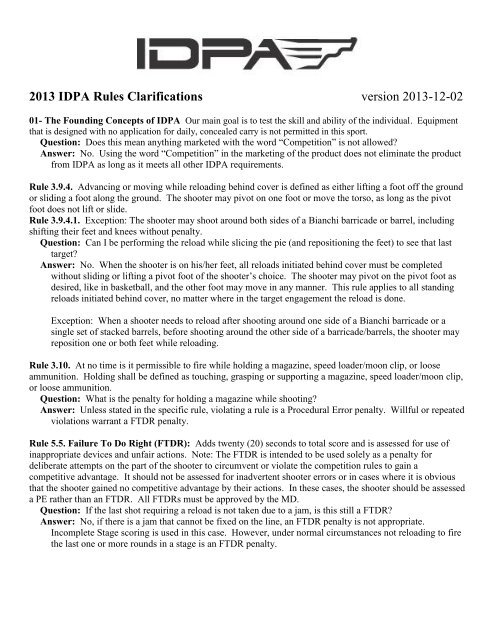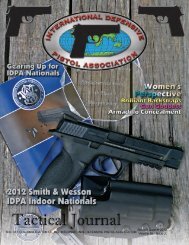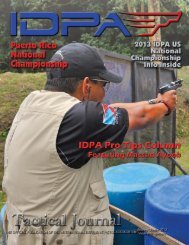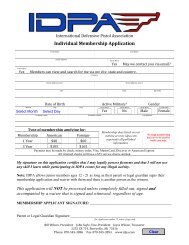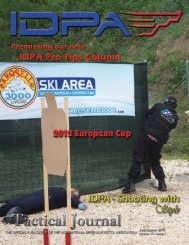2013 IDPA Rules Clarifications version 2013-12-02 - IDPA.com
2013 IDPA Rules Clarifications version 2013-12-02 - IDPA.com
2013 IDPA Rules Clarifications version 2013-12-02 - IDPA.com
Create successful ePaper yourself
Turn your PDF publications into a flip-book with our unique Google optimized e-Paper software.
<strong>2013</strong> <strong>IDPA</strong> <strong>Rules</strong> <strong>Clarifications</strong> <strong>version</strong> <strong>2013</strong>-<strong>12</strong>-<strong>02</strong><br />
01- The Founding Concepts of <strong>IDPA</strong> Our main goal is to test the skill and ability of the individual. Equipment<br />
that is designed with no application for daily, concealed carry is not permitted in this sport.<br />
Question: Does this mean anything marketed with the word “Competition” is not allowed?<br />
Answer: No. Using the word “Competition” in the marketing of the product does not eliminate the product<br />
from <strong>IDPA</strong> as long as it meets all other <strong>IDPA</strong> requirements.<br />
Rule 3.9.4. Advancing or moving while reloading behind cover is defined as either lifting a foot off the ground<br />
or sliding a foot along the ground. The shooter may pivot on one foot or move the torso, as long as the pivot<br />
foot does not lift or slide.<br />
Rule 3.9.4.1. Exception: The shooter may shoot around both sides of a Bianchi barricade or barrel, including<br />
shifting their feet and knees without penalty.<br />
Question: Can I be performing the reload while slicing the pie (and repositioning the feet) to see that last<br />
target?<br />
Answer: No. When the shooter is on his/her feet, all reloads initiated behind cover must be <strong>com</strong>pleted<br />
without sliding or lifting a pivot foot of the shooter’s choice. The shooter may pivot on the pivot foot as<br />
desired, like in basketball, and the other foot may move in any manner. This rule applies to all standing<br />
reloads initiated behind cover, no matter where in the target engagement the reload is done.<br />
Exception: When a shooter needs to reload after shooting around one side of a Bianchi barricade or a<br />
single set of stacked barrels, before shooting around the other side of a barricade/barrels, the shooter may<br />
reposition one or both feet while reloading.<br />
Rule 3.10. At no time is it permissible to fire while holding a magazine, speed loader/moon clip, or loose<br />
ammunition. Holding shall be defined as touching, grasping or supporting a magazine, speed loader/moon clip,<br />
or loose ammunition.<br />
Question: What is the penalty for holding a magazine while shooting?<br />
Answer: Unless stated in the specific rule, violating a rule is a Procedural Error penalty. Willful or repeated<br />
violations warrant a FTDR penalty.<br />
Rule 5.5. Failure To Do Right (FTDR): Adds twenty (20) seconds to total score and is assessed for use of<br />
inappropriate devices and unfair actions. Note: The FTDR is intended to be used solely as a penalty for<br />
deliberate attempts on the part of the shooter to circumvent or violate the <strong>com</strong>petition rules to gain a<br />
<strong>com</strong>petitive advantage. It should not be assessed for inadvertent shooter errors or in cases where it is obvious<br />
that the shooter gained no <strong>com</strong>petitive advantage by their actions. In these cases, the shooter should be assessed<br />
a PE rather than an FTDR. All FTDRs must be approved by the MD.<br />
Question: If the last shot requiring a reload is not taken due to a jam, is this still a FTDR?<br />
Answer: No, if there is a jam that cannot be fixed on the line, an FTDR penalty is not appropriate.<br />
In<strong>com</strong>plete Stage scoring is used in this case. However, under normal circumstances not reloading to fire<br />
the last one or more rounds in a stage is an FTDR penalty.
Rule 6.13. Only one (1) non-threat target may be used for every three (3) threat targets in any string of fire.<br />
Stage designers may use one non-threat for 1 to 3 threats, 2 non-threats for 4 to 6 threats and 3 non-threats for<br />
7- 9 threats, etc.<br />
Question: Can humanoid shaped vision barriers be used in a stage?<br />
Answer: No. Stage designers may elect to use props as vision barriers (barrels, chairs, cardboard painted<br />
the appropriate color, etc.). Humanoid shapes of any kind either partial or whole may not be used as<br />
vision barriers. Tactical dummies or mannequins may still be used as props, but not as vision barriers.<br />
Rule 8.2.1.3.4. Recoil spring guide rods and dual spring recoil systems made of material that is no heavier than<br />
stainless steel.<br />
Question: Is as an extended guide rod in a G34/35 SSP legal?<br />
Answer: No. Guide rods extended beyond factory length are not allowed in SSP.<br />
Rule 8.2.1.1.6. The firearm with the largest magazine inserted must fit in the <strong>IDPA</strong> gun test box measuring 8<br />
¾” x 6” x 1 5/8”.<br />
Rule 8.2.2.1.4. The firearm with the largest magazine inserted must fit in the <strong>IDPA</strong> gun test box measuring 8<br />
¾” x 6” x 1 5/8”.<br />
Rule 8.2.3.1.4. The firearm with the largest magazine inserted must fit in the <strong>IDPA</strong> gun test box measuring 8<br />
¾” x 6” x 1 5/8”.<br />
Question: What does “fit in the box,” mean?<br />
Answer: The firearm must be fully assembled, magazine inserted, slide in battery, and must fully fit into the<br />
box with the lid shut. An adjustable rear sight may be <strong>com</strong>pressed to fit into the box, and the lid may be<br />
held shut with light pressure, but not enough force to flex a part on the firearm, flex the box or the lid, or<br />
indent the box or lid material.<br />
Rule 8.2.2.3. ESP Excluded Features and Modifications (Non-Inclusive list):<br />
Rule 8.2.2.3.2. Removal of material from the exterior of the slide other than front cocking serrations, tri-top,<br />
engraving, carry melts, and high power cuts.<br />
Rule 8.2.3.3. CDP Excluded Features and Modifications (Non-Inclusive list):<br />
Rule 8.2.3.3.2. Removal of material from the exterior of the slide other than front cocking serrations, tri-top,<br />
engraving, carry melts, and high power cuts.<br />
Question: Is the Lone Wolf 21T slide legal in CDP or ESP?<br />
Answer: The model LWD-SLIDE21T is not allowed due to the large cutout in the top. Model LWD-<br />
SLIDE21TS is allowed.
Rule 8.2.5.3.2. Hogue Big Butt grips and similar are not allowed.<br />
Question: what does “and similar” mean?<br />
Answer: The maximum grip dimensions allowed are:<br />
5.00” (<strong>12</strong>7mm) maximum height, measured from the bottom of the hammer opening in the frame to the<br />
bottom of the grip<br />
2 3/8” (60.3mm) maximum depth.<br />
1 5/8” (41.3mm) maximum width<br />
If any dimension is exceeded, the grip is not allowed. Measurements will be taken as shown below:<br />
Height Measurement: 5.00” (<strong>12</strong>7mm) maximum
Depth Measurement: 2-3/8” (60.3mm) maximum
Width Measurement: maximum 1-5/8” (41.3mm) maximum<br />
Rule 8.3.2.1.2. If the <strong>com</strong>petitor’s ammunition fails to make power factor, the <strong>com</strong>petitor will have the option<br />
to chronograph three additional rounds through his/her own firearm or another firearm of maximum barrel<br />
length for the division. Prior to each shot, the muzzle of the firearm will be elevated to move the powder charge<br />
to the rear of the case.<br />
Question: can revolver ammunition be chronographed using a semi-auto firearm with the maximum barrel<br />
length allowed for the revolver division?<br />
Answer: A firearm used for chronograph purposes must be legal in the same division as the shooter’s<br />
firearm.<br />
Rule 8.4. Belts: Belts may be no wider than 1 ¾ inches/44.5mm or thicker than 5/16 inches/7.94mm and must<br />
pass through a minimum of all but two of the pant loops.<br />
Question: Must pants have belt loops?<br />
Answer: Yes, pants, shorts, skirts, kilts, etc., must have belt loops.
Ex. 8.5.1.17. Not Legal, fails dowel test and 8.3. Illegal belt<br />
Question: Does this mean the belt shown is always disallowed.<br />
Answer: No. When either the inner or the outer belt is worn by itself and meets the criteria of rule 8.4 it is<br />
allowed.
Rule 8.6.2.6. Magazine carriers with screws or knobs that extend past the outer face of the carrier are not legal.<br />
Question: does this include magazine carriers with nearly flush machine screws on the outer face?<br />
Answer: Magazine carries with tension screws on the outer face like the ones pictured below are allowed if<br />
the adjustment screw(s) require a tool to change tension, the screws protrude less than 0.<strong>12</strong>5” (3.18mm)<br />
from the outer face of the magazine carrier, and they meet all other magazine carrier requirements.<br />
Additionally, all tension screws anywhere on a magazine carrier must require a tool for tension<br />
adjustment.<br />
.<br />
<strong>2013</strong> Match Administration <strong>Clarifications</strong><br />
Rule: 1.2.3. Awards At Tier two (2) and higher matches, trophies will be awarded based on number of<br />
contestants per class and division (including DQs and DNFs, but not including no-shows) and go to the top fifth<br />
of those <strong>com</strong>petitors. One (1) award should be awarded for every five (5) shooters entered in a particular<br />
division and class. Sanctioned matches must give trophies or plaques for the Division Champions as well as<br />
1st, 2nd, and 3rd placements. The remaining awards (4th place and on and subcategories) may be medal or<br />
medallions, etc.<br />
Question: Do we really have to give out a third place trophy for a class and division with only three people<br />
entered?<br />
Answer: No. At Tier two (2) and higher matches, awards will be given based on number of contestants per<br />
class and division (including DQs and DNFs, but not including no-shows) and go to the top fifth of those<br />
<strong>com</strong>petitors. Tier two and higher matches will provide one award for 1 to 5 entrants, two awards for 6 to<br />
10 entrants, three awards for 11 to 15 entrants, four awards for 16 to 20 entrants, etc.<br />
Tier two and higher matches must give trophies or plaques for the Division Champions as well as 1st, 2nd,<br />
and 3rd placements, if there are enough entrants to warrant these awards. The remaining awards (4th<br />
place and on and subcategories) may be medals or medallions, etc., when there are enough entrants to<br />
warrant them.
Rule: 1.2.4.11. On the day of the match, your age determines the category:<br />
Junior Member (<strong>12</strong>th birthday through 17 years of age)<br />
Typical Member (18th birthday through 49 years of age)<br />
Senior Member (50th birthday through 64 years of age)<br />
Distinguished Senior Member (65th birthday and older)<br />
Question: Can 18-21 year old shooters shoot a match without a parent or guardian present?<br />
Answer: Yes, if allowable based on range policies, federal, state, and local law. Junior members must have<br />
a parent or guardian present.<br />
Rule: 2.2. <strong>IDPA</strong> Safety Officer Qualifications<br />
Rule: 2.2.2.1. Be at least 21 years of age and be able to lawfully possess a firearm under the laws of your<br />
country of residence.<br />
Question: Can an 18-21 year old shooter be<strong>com</strong>e a certified SO?<br />
Answer: No. A shooter may not be<strong>com</strong>e a certified SO until they turn 21, but they can attend an SO class<br />
and work Tier 1 matches for experience without a certification.


